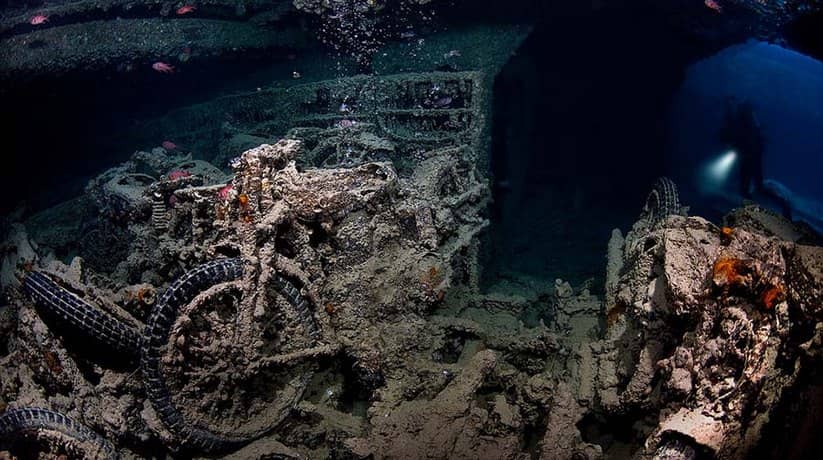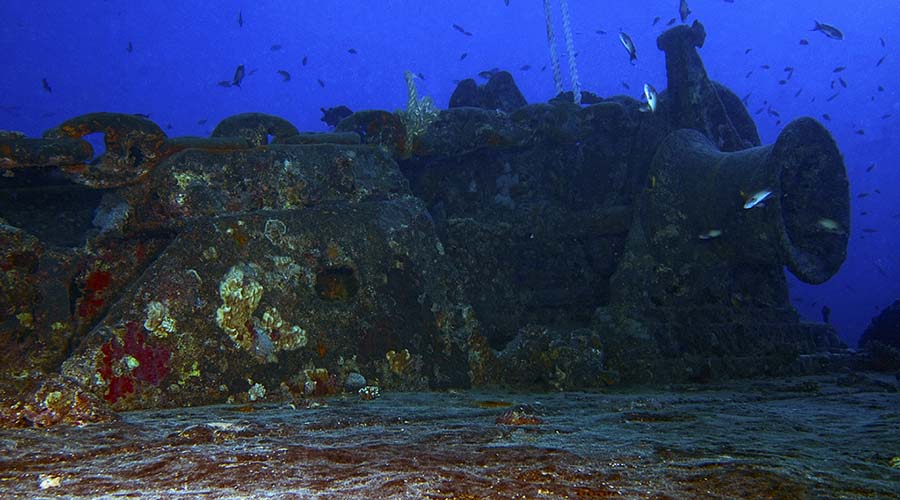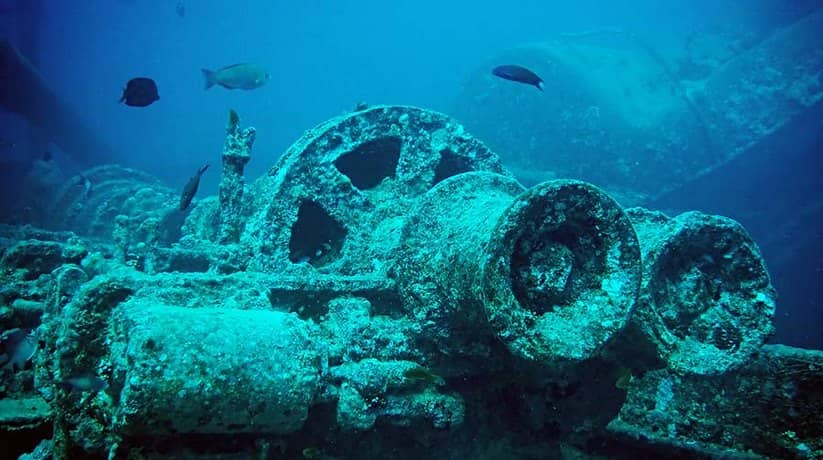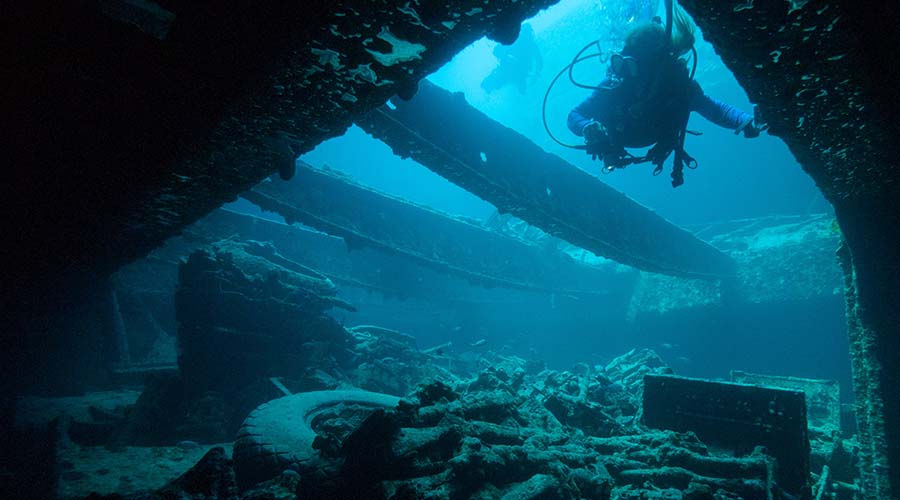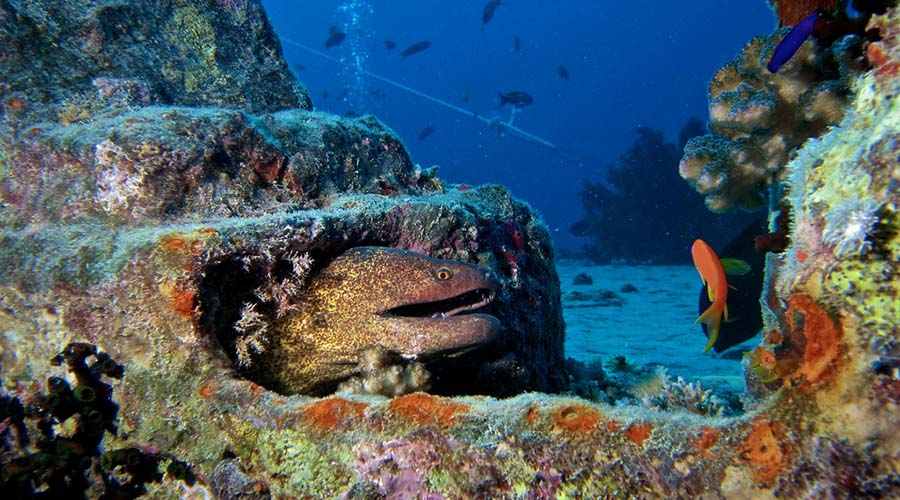.
SS Thistlegorm Sharm information, tours, prices and online booking
SS Thistlegorm Sharm built by Joseph Thompson & Sons of Sunderland and launched in June 1940. It was 126.5m in length and displaced 4,898 gross tones. Powered by a triple-expansion, 3 cylinder steam engine that generated a very comfortable 365 nominal horsepower. It was one of a number of “Thistle” ships owned and operated by the Albyn Line. Its construction being part funded by the British Government. However, it was destined for “War” duties from the moment it was launched.
Despite the manner of its sinking and the ongoing destruction, SS Thistlegorm Sharm is still in remarkable condition. The front section remains largely intact and sits upright on a sandy seabed at a maximum depth of 32 meters. The starboard anchor deployed and some railing are still in place. Moreover, all the winch houses, winches, blocks, windlasses and other paraphernalia are still there. On the main deck there is a railway water carrier on either side of No 1 Hold. It is with the one on the port side resting precariously over the edge of the Hold. Each hold built in two levels with the upper level known as “tween decks”. Basically, these tween decks are, in effect, a large shelf that stretched under the decks of the ship.
More information about SS Thistlegorm in Sharm:
There are Bedford trucks and a number of Motorcycles on the starboard side. Whilst the same found on the port side, the top of the hold bent downwards. It is with the presence of the water carrier, perched somewhat menacingly over the edge. It tends to be less well visited. Inside No 1 Hold, the cargo of parts and spares has come to look like an accumulation of debris. In fact, it obscures anything of greater interest – including more vehicles. Back at deck level, there is a Tender Railway on each side of No 2 Hold beside which are two “torpedo” shaped Paravanes. Once again there are some very interesting vehicles in the tween decks but below these on the port side. In fact, the diver will discover two large Armored Cars – built on Rolls Royce Chassis.
The starboard side of No 2 Hold, however, is where an incredible journey begins. Swimming gently above the vehicles, there is plenty of room to explore and inspect the various Lorries, Trailers, Motorcycles and other items as you journey below the bridge and pass through No 3 hold. Here are the small arms – weapons of various caliber in packs of 6 or 8 placed “Butt to Muzzle“. Each pack now concreted together as a single entity. Beyond this, is the fuel store – virtually empty after such a long journey. To one side, however, there is a large gap where the diver is able to exit through the bulkhead which once formed the bulkhead between No 3 and No 4 Hold.
Further information about the diving site:
Emerging into the daylight, the Diver is confronted by the devastation that surrounded the sinking. Ammunition boxes form a large pile of fairly uniform debris – on top of which is an up-turned tracked Bren Carrier. Pointing towards the stern is the broken drive shaft and some 20m further on is the remainder – sticking out of what remains of the stern. Below us, are a number of very large shells – possibly 14 inch, once destined for a British Capital Ship. The stern itself is canted over at an angle of 45 degrees and is as interesting as any other part of the ship. The two deck-mounted guns are still in place and are best viewed from below – where they make excellent silhouettes against the distant surface.
By now it is time to head back – swimming just above the wreck as we do so. Once again we pass over the most extensively damaged area before encountering that decking which was “peeled” back and now reaches almost to the Bridge. The evenly spaced steel girders which once supported the deck are now on top and who knows what lies trapped below. Off the port side, we see the remains of one of the two Railway Engines – remarkably, it is upright the seabed. Then we arrive at the Bridge and, although stripped bare long ago, still well worth a visit.
More details about SS Thistlegorm in Sharm:
A gentle current generally prevails from bow to stern. Large Grouper, Blacktip Sharks, Jacks and Tuna are amongst the largest fish encountered. It is with the latter two species providing an early morning display of speed and agility as they attack shoals of smaller fish at breakfast time. All the common Reef Fishes are also present.
The shipwreck facts:
- Dive Site: SS Thistlegorm.
- Description: Container ship.
- Length: 126 meters (413 feet).
- Depth: 16 – 33 meters (52 – 108 feet).
- Visibility: 20 – 30 meters (65 – 100 feet).

